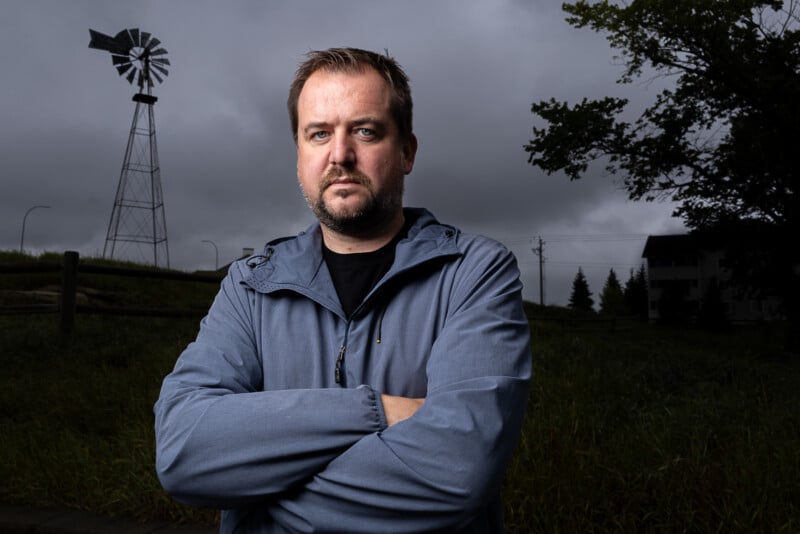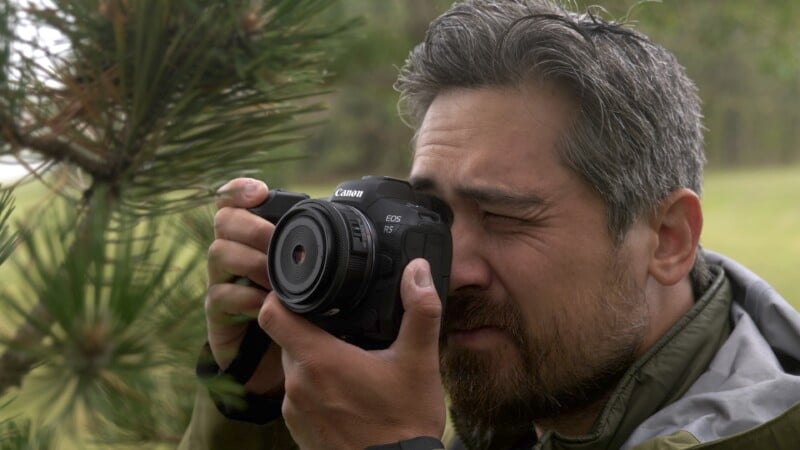If there was ever a focal length that the manufacturers tend to put by the wayside, it’s the trusty 28mm prime lens. You see, ultra-wide lenses are dynamic and 24mm lenses are admittedly more versatile. However, the 28mm range is probably my preferred focal length for walking the streets with only one prime lens. You can capture more of the story, or crop down if you want a tighter view. They are typically compact and optically well-designed. The new Canon RF 28mm f/2.8 is no exception.
Canon RF 28mm f/2.8: How It Handles
Announced along with the R100 back in May, the new lens weighs in in at a minuscule 4.25 ounces (121 grams), the adorable 28mm is a true pancake design that can go anywhere with you. It’s the perfect lens to slap on a compact Canon body and head out with only one optic for the day. Despite the incredibly light weight, the 28mm does have a metal mount, although it incorporates no weather sealing.

At the front of the lens is a very nicely finished metal control ring. This ring has three selectable options: full manual focus, autofocus (which basically disables the ring), and the ability to use it as a customizable control dial. Regardless, despite its thin proportions, the metal ring is well-dampened and easy to use. The front elements are tiny so there is no danger of fingers getting in the shot while manipulating the control ring.

Canon RF 28mm f/2.8: In the Field
Many wide-angle primes double as decent close-up lenses, but sadly this is not the case with the 28mm. The lens doesn’t physically focus close at all; a flower shot will generally include the entirety of the plant as well. Fairly shallow depth of field can be achieved when getting up close to your subjects, however, and you can make some interesting shots with the wide-angle sense of perspective.

I was pleasantly surprised with how this lens handles bright light sources in the frame. The Canon lens coatings resisted washed-out flare and loss of contrast. When stopped down there was some minor green colored ghosting, but overall it performed well. There is no hood provided with the Canon 28mm f/2.8 but luckily it seems you don’t really need one.

Specular highlights at f/2.8 did exhibit a fair amount of “cat’s eye” effect in the corners but this went away by f/5.6. The highlights exhibit a slightly polygonal look when stopped down, but were largely free of onion-rings or a strong soap-bubble effect. I found the overall bokeh of out of focus areas to be smooth, but tipping towards a harsh look. Backgrounds can look a little frenetic but keep in mind that this is largely only a factor when shooting close-up at wider apertures.

Canon RF 28mm f/2.8: Can You Take It to the Movies?
I was hoping that this little 28mm would be a good video lens, but it’s a bit of a mixed bag. While the manual focus is buttery smooth, there is a fair amount of lens breathing present. “Breathing” refers to the changing of the field of view in the shot when focusing from near to far. It looks like the frame is zooming in and out, and is very present when using this lens.
Due to its compact nature, this lens would make sense on a floating gimbal since it is easy to balance and adds almost no weight. I would not be adverse to using it for some video work. It wont really deliver anything better — or worse — than the 28mm range on an f/2.8 zoom lens, but it will be much smaller to handle.
Canon RF 28mm f/2.8: Is This Lens Sharp or Fluffy Like a Pancake?
Back in the day, lenses typically delivered softer images when shot at the widest aperture. You’d have to stop down the lens one or two stops to really get them to sharpen up. What we’ve seen with modern lenses is a real shift to excellent sharpness even at the brightest apertures. Often, stopping down creates a negligible improvement to sharpness.

Looks like the Canon RF 28mm f/2.8 is a trip down memory lane, then. Shooting at f/2.8 produces somewhat soft images regardless of whether you are looking at the center of the image or the corners. To be fair the images are still totally usable at f/2.8 but this is a lens that I would consciously be aiming to stop down even to f/4 when possible.
Canon RF 28mm f/2.8: I’d Eat This Pancake
This lens has some ups and downs, but it does provide an ultra-compact and much needed wide angle range to the RF system. The lens is affordable at $299 and would be an ideal travel companion or daily walkabout lens. I could see this lens on a full-frame Canon as a kind of analogue to a Fujifilm X100V or Ricoh GR. However, I’d also consider this lens for an APS-C sensor body like the R7 or R100. It’s gonna convert to a fairly normal 45mm prime lens and it’s not adding the bulky burden that most full-frame lenses do.

Are There Alternatives?
Nope. Canon does make a couple wide angle primes like the 24mm Macro and 16mm f/2.8 STM, but they are trying to do different things. Getting an expensive zoom like the 15-35mm f/2.8 L IS USM is so beyond what this little 28mm is trying to be that it’s barely worth mentioning.
Should You Buy It?
Yes. It’s a good little lens and as mentioned above there isn’t really another option, so if you are intrigued by a compact little 28mm prime this is the one — and only — choice.

